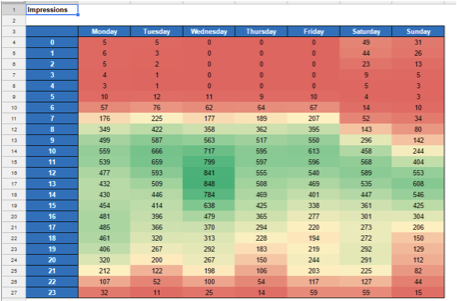
The first question to ask yourself when considering how often to post on social media is how often your audience will find it interesting. The purpose of your post should be clear to your audience. If your post is completely unrelated to what your brand stands for, people may wonder what the point of your post is. Relevant posts increase social media's popularity and are more useful. If your post seems wildly insignificant, your audience will be bored and move on.
LinkedIn recommends posting at the least three times per workweek
Posting on LinkedIn can be effective if you can optimize your content for a specific day of the week. Posting on Wednesdays at 12:00 pm is the best time to engage users. Studies have shown this. Additionally, Fridays and Mondays are the least popular days and their usage drops dramatically. Although posting on LinkedIn every day might not be the best strategy, it can increase engagement and boost your profile.
LinkedIn recommends that you post at least two to five times per day on the social network. However, you can post up to 20 times per month. It is up to you and your capacity to post content, but the rule of thumb is that at least three posts per week are sufficient. Your posts should include both promotional and owned content. Posts should be made at the beginning of each week and not during business hours.

Twitter recommends posting at least 30 times per day
Post 30 times per day for maximum engagement on Twitter. You should remember that every audience is different. A nightclub, for example, will not have traditional daytime viewers. Instead, you'll see clusters of activity leading to the evening shows. Even if your tweets don't reach the entire audience, it will still be read by a substantial amount of them.
Even though you should not post more than 30 times per hour, most people are fine with posting five to seven times per day. The engagement on the fourth or subsequent tweets is usually lower. It is more likely that you will see lower returns if your posts are more frequent. If you have high engagement rates and many followers, posting more often is not always better. Regardless of the optimal number of tweets per day, you'll need to keep in mind your audience's attention span.
Pinterest recommends posting at minimum once per day
Pinterest offers a lot of information on using its algorithm to boost pins. But there are some things you should remember if your goal is to achieve the best results. It's best to publish at least one pin per day. However, this can change as your audience grows. In addition, you should make sure to engage with your pins by visiting their boards. However, don't overdo it and don't post too much content if your pins aren't relevant or spammy. Instead, try to create visually appealing content.
Although you can pin multiple pins on Pinterest you should not spam the users. You should limit your pins to 15 per day. This will increase the popularity of your page and reduce the chance that you will be unfollowed. Great content should be repinned at least once a day. This will increase your traffic, and it will also meet Pinterest's algorithm requirements.

Facebook recommends posting at least three times a week
Overposting on Facebook can be frustrating for followers and fans. Facebook suggests that your page should be updated between three and seven times per week. But, it is important to strike a balance between quantity and frequency. Facebook's algorithm rewards high-quality posts, and posting too much can look spammy. You should post no more often than three times per week. Then, you can start posting once a day.
Each social media site is different so there's no one posting frequency. You can however follow these guidelines to get you started. Posting on Facebook for business purposes should be limited to three to five posts per week. Each platform has a different optimal number, so don’t feel pressured into posting more than you can handle.
FAQ
What length should my content marketing last?
This depends on your goals. Businesses may be looking for immediate results, while others want long-term growth. We recommend starting with three consecutive months of content creation, then reviewing the results after that period.
How can content marketing be measured for success?
There are many ways you can measure the success of your content marketing strategies.
Google Analytics is one of the best measurement tools. This tool can show you where your targeted traffic originates and what pages they visit the most often.
It also tells you how long each visitor stays on your site before leaving.
This data can be used to improve content to attract people's interest and keep them engaged for longer durations.
These questions can also help you determine the success of your content marketing efforts.
What value do my new subscribers receive from my email bulletins? What percentage of my mailing list have purchased paid memberships? How many people have clicked through to my landing page? Does clicking through result in higher conversion rates?
These are all important metrics to track and monitor over time.
Lastly, another great way to measure content marketing success is to look at the number of times people share links to your content across social networks.
Consider starting now if this is something you aren't doing. It could make all the difference in whether you are seen or ignored in your industry.
What is the difference in content marketing and content creation?
Content marketing is the idea of all great brands having the same message. They provide valuable information that people need and want.
Content marketers are experts in creating the right content to fit each channel and at different times.
They also understand how to develop an effective strategy around promotion and distribution.
That is, they think strategically about the things they do and what it means.
This is the core skill set needed to be a successful content marketer.
Statistics
- Progress indicators (0–100%) allow each team member to see how attainable each goal is and understand what remains to be accomplished. (semrush.com)
- According to our research, 65% of companies with very successful content marketing in 2021 ran content audits at least twice a year. (semrush.com)
- Content marketing produces 3X more leads per dollar spent. Content marketing costs 62% less than traditional marketing. (criteo.com)
- Seventy-two percent business to business (B2B) (mailchimp.com)
- We found that 40% of businesses don't have a documented strategy yet. (semrush.com)
- An example of an overarching goal could be: "In 2022, we want to achieve a 20% increase in revenue created by organic content and generate 15,000 MQLs with a budget of $30,000." (semrush.com)
- Measure your goals with a progress indicator of 0-100%. Make your goals collaborative and transparent (semrush.com)
- To further show the importance of this, 89% of people have stopped doing business with a company because of a poor experience. (neilpatel.com)
External Links
How To
Infographic Creation Tips for Content Marketing
Infographics are an effective way to explain complicated concepts clearly and make information understandable. Use infographics as a tool to promote your content marketing message.
You'll need design software such as Adobe Illustrator or Photoshop to create an infographic. These programs allow you to create infographics by drawing different shapes and elements. You can then use colors and fonts for your data. After your design is complete, you can upload images from Unsplash and Pixabay to your design.
Check out existing infographics online to get some ideas. To show how many calories certain foods have, you can use a picture of a pyramid to illustrate this. You could also replace the numbers with images of the food. Or you could look at how many sugars are found in soda pop and replace that number with a picture from a Coke bottle.
Once you have designed your infographic you can share it via social media channels, such as Facebook or Twitter. This allows people to learn more about the concept, even if they aren't familiar. You can include hashtags in your infographic if you want to share it on social media. Users can follow along with specific conversations using hashtags.
If you decide to create an infographic, try making your posts shorter than usual. An average blog post can range from 2000 to 5000 word, while an informationgraphic needs only 500 to 1000 words. This means that you can convey more information in a shorter space.
When designing your infographic, remember that some viewers may struggle to read small font sizes. Make sure you use large enough fonts and don't rely too heavily on color for your graphics. Make sure all text is legible.
These are just a few additional tips.
-
Choose an Infographic Template. There are many free templates online. The most popular ones include Canva, Piktochart, and Google Slides.
-
Create your Infographic. You can use the template to create your infographic. Any media you choose is acceptable for your audience. In this example, photos of Seattle restaurants might be used to create an infographic about Seattle's best restaurants.
-
Add Text. Add text to your infographic once you have it created. You can use Microsoft Word, PowerPoint or Canva to add text.
-
Add images. Images can be added to your infographic. You can add images to your infographic. If you want to add a picture, make sure it's relevant to your topic.
-
Make It Interactive. You can add interactive elements, such as maps, buttons, and links. This will increase engagement with your audience.
-
Share. Share your infographic when you are done.
-
Measure. How well did your infographic perform? Are people clicking through to your website or not? Did they sign-up for your email address? What was their reaction to your infographic?
-
Improve. Is there a way to improve your infographic? Could you do better next time?
-
Repeat. Do this again!